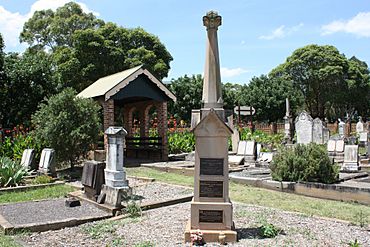Mays Hill, New South Wales facts for kids
Quick facts for kids Mays HillSydney, New South Wales |
|||||||||||||||
|---|---|---|---|---|---|---|---|---|---|---|---|---|---|---|---|

Mays Hill Historic Cemetery
|
|||||||||||||||
| Population | 767 (2016 census) | ||||||||||||||
| Postcode(s) | 2145 | ||||||||||||||
| Elevation | 40 m (131 ft) | ||||||||||||||
| Location | 24 km (15 mi) west of Sydney CBD | ||||||||||||||
| LGA(s) |
|
||||||||||||||
| State electorate(s) |
|
||||||||||||||
| Federal Division(s) | Parramatta | ||||||||||||||
|
|||||||||||||||
Mays Hill is a suburb located in Sydney, New South Wales, Australia. It is about 24 kilometres west of the main city centre of Sydney. Mays Hill is part of the Greater Western Sydney area. It falls under two local councils: the Cumberland Council and the City of Parramatta.
Contents
Getting Around Mays Hill
Mays Hill has a stop on the T-80 T-Way bus service. This makes it easy to travel by bus. Several other CDC NSW bus routes also serve the area.
The Story of Mays Hill
Long ago, some of the land that is now Mays Hill was owned by the governor. This large area was later divided up. A wealthy businessman named Thomas May bought some of this land.
Many people thought Mays Hill was named after Thomas May. However, this is not true! A painting from 1840 by George Edwards Peacock shows the area was already called Mays Hill. This was long before Thomas May had anything to do with the Parramatta area, which was in 1859. So, the name "Mays Hill" was around much earlier.
People of Mays Hill
Mays Hill is home to a diverse group of people. Many different backgrounds and cultures are represented here.
- The most common family origins include English, Australian, Chinese, Lebanese, and Indian.
- People from many countries live here. The most common countries of birth are India, China, Lebanon, Afghanistan, and Sri Lanka.
- Many languages are spoken in Mays Hill. Some common languages include Arabic, Mandarin, Tamil, Gujarati, and Cantonese.
- People in Mays Hill follow various religions. The most common religions are Catholic, Hinduism, Islam, and Anglican. Many residents also report having no religion.
Mays Hill Cemetery: A Historic Place
The Mays Hill Cemetery is a very old and important place. It is one of four historic cemeteries in the City of Parramatta area. This cemetery holds the graves of many early families who helped build the local community.
Some of these well-known families include the Paytens, Fullagars, Houisons, Downs, Ardills, and Mustons. The cemetery was once called Western Road Cemetery. This was because it is located right on the Great Western Highway.


